Jaipur travel - India, Asia
Jaipur, the capital of Rajasthan, is a vibrant city known as the "Pink City" for its distinctive rose-colored buildings. Founded in 1727 by Maharaja Sawai Jai Singh II, Located in the northeastern part of Rajasthan, approximately 268 kilometers (167 miles) from New Delhi. The city is situated at an altitude of 431 meters (1,417 feet) above sea level and is surrounded by the Aravalli hills, providing a picturesque backdrop. The city covers an area of about 467 square kilometers (180 square miles) and is strategically positioned near the Thar Desert. Jaipur's rich cultural heritage, stunning architecture, and colorful festivals make it a popular tourist destination, often visited as part of the Golden Triangle circuit along with Delhi and Agra. Travelers can immerse themselves in the city's art, crafts, and cuisine, from intricate jewelry to delectable dishes like dal-baati-churma and pyaaz kachori.
Population: Approximately 4.300.000 people as of 2024.
Economy: Jaipur's economy is diverse and vibrant, driven primarily by tourism, gemstone cutting, and the manufacture of jewelry and luxury textiles. The city is a significant hub for arts and crafts, with a thriving market for handicrafts, textiles, and traditional Rajasthani goods, attracting both domestic and international tourists.
Attractions: Amer Fort, City Palace, Hawa Mahal, Jal Mahal, Nahargarh Fort, Jaigarh Fort, Jantar Mantar
India
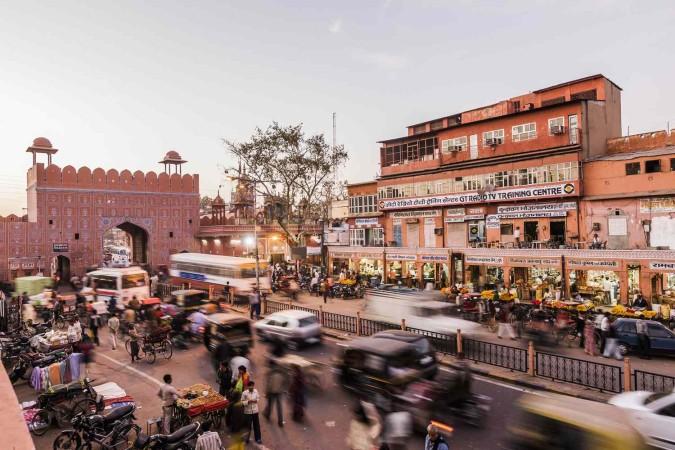
Overview of Jaipur
History & Cultural Influence
Back in 1727 when founded by Maharaja Sawai Jai Singh II, Jaipur was designed as a planned city, with wide streets and markets, and was painted in distinctive pink hues to welcome the Prince of Wales in 1876, earning it the moniker "Pink City".
The city's historical significance is evident in its magnificent forts and palaces, such as the Amer Fort, Jaigarh Fort, Nahargarh Fort, and the City Palace, which stand as testaments to Jaipur's regal past. These architectural wonders, many of which are now UNESCO World Heritage sites, showcase the intricate craftsmanship and grandeur of the Rajput era.
Jaipur's cultural influence extends beyond its historical landmarks. The city is a hub for arts and crafts, with traditional shops selling exquisite block prints, sculptures, stone carvings, and the famous blue pottery. The city's cultural vibrancy is also evident in its lively festivals, such as the Elephant Festival, Gangaur Festival, and Holi, which attract visitors from around the world.
Interaction with The Locals
Predominantly composed of Hindus, with significant communities of Jains and Muslims, contributing to a rich cultural diversity. Visitors to Jaipur can expect warm and friendly interactions with the locals, who are known for their hospitality and openness to tourists.
The general attitude towards tourists in Jaipur is positive; locals often enjoy engaging with visitors, sharing stories about their culture, and offering assistance. Many residents are involved in the tourism industry, which has fostered a welcoming environment. You can expect to find locals eager to share their knowledge of the city's history, traditions, and customs.
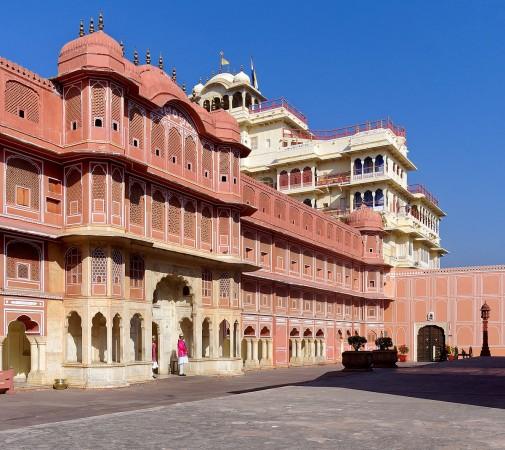
City Palace - © Jakub Hałun
Top attractions in Jaipur
From the majestic Amber Fort, where you can explore grand palaces and stunning views, to the iconic Hawa Mahal, with its intricate latticework and historical significance, Jaipur offers a captivating journey into the royal past of Rajasthan. The city's colorful bazaars and magnificent palaces make it a must-visit for anyone seeking to experience India's regal charm.
Amer Fort
Location: Devisinghpura, Amer, Jaipur, Rajasthan
Amer Fort is a majestic fort complex situated about 11 km from Jaipur, known for its captivating blend of Hindu and Muslim architecture. As a UNESCO World Heritage Site, it offers you the chance to experience royal history firsthand, with highlights including an unforgettable elephant ride up the hill, providing panoramic views of the city.
Hawa Mahal (Palace of Winds)
Location: Hawa Mahal Rd, Badi Choupad, J.D.A. Market, Pink City, Jaipur, Rajasthan
Hawa Mahal, with its iconic pink honeycomb-like facade, stands as one of Jaipur’s most famous landmarks. Built in 1799, this palace was designed for royal ladies to discreetly observe the vibrant street life below. Today, you can explore its beautifully preserved rooms and the museum that showcases Jaipur’s rich heritage.
City Palace
Location: Tulsi Marg, Gangauri Bazaar, Jaipur, Rajasthan
City Palace is an architectural masterpiece that blends Rajput and Mughal styles, located in the heart of Jaipur. Within its grand complex, you can discover stunning palaces, serene temples, lush gardens, and the renowned museum. Don’t miss the Chandra Mahal, Mubarak Mahal, and the impressive Diwan-i-Khas and Diwan-i-Aam halls.
Jantar Mantar
Location: Gangori Bazaar, J.D.A. Market, Pink City, Jaipur, Rajasthan
Jantar Mantar, an 18th-century astronomical observatory, is a must-see UNESCO World Heritage Site in Jaipur. It houses a remarkable collection of architectural instruments used for celestial observations. You can delve into the fascinating world of astronomy as you explore these historical devices and their functions.
Birla Mandir (Laxmi Narayan Temple)
Location: Jawahar Lal Nehru Marg, Jaipur, Rajasthan 302004
Birla Mandir, a stunning white marble temple dedicated to Lord Vishnu and Goddess Lakshmi, is one of Jaipur’s most serene attractions. Built in 1988, this temple not only serves as a place of worship but also offers you breathtaking views of the city from its picturesque hilltop setting.
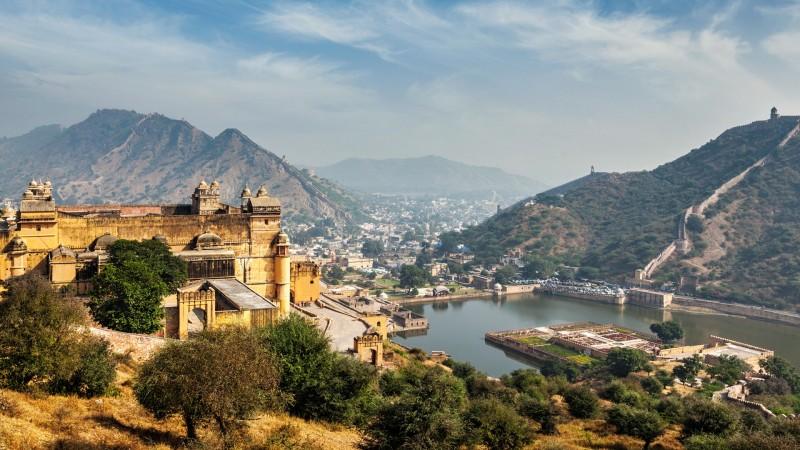
Amber Fort - © gather
Must-Try Dishes in Jaipur
Jaipur's culinary scene is a feast for the senses, offering must-try dishes like Dal Baati Churma, a flavorful combination of spiced lentils, baked wheat balls, and sweet crumbled bread that captures the essence of Rajasthani cuisine. Don't miss Laal Maas, a rich and spicy mutton curry that showcases the bold flavors Jaipur is known for, making your culinary journey in the Pink City truly unforgettable.
Dal-Baati-Churma
A quintessential Rajasthani experience, Dal-Baati-Churma brings together three components: baati (baked whole wheat rolls), dal (flavorful lentil curry), and churma (a sweet made from crushed baati, ghee, and sugar). This iconic dish is a must-try for anyone looking to taste the heart and soul of Rajasthan.
Laal Maas
Laal Maas is a fiery red meat curry, where tender mutton or lamb is cooked in a rich gravy of yogurt, red chilies, and traditional Rajasthani spices. This dish is perfect for those who love bold, intense flavors and want to experience the spicy side of Jaipur's cuisine.
Pyaaz Kachori
Pyaaz Kachori is a deliciously crispy pastry filled with a spicy onion mixture, deep-fried to perfection. Often enjoyed with tangy tamarind or mint chutney, this popular Jaipur snack is a must-try, especially from the famous Rawat Mishthan Bhandar.
Gatte ki Sabzi
Gatte ki Sabzi features gram flour dumplings (gatte) simmered in a spiced yogurt-based gravy. This beloved Rajasthani dish pairs wonderfully with rice or roti, offering a taste of the region's unique culinary traditions.
Ghevar
Ghevar is a traditional Rajasthani sweet, especially popular during festivals. This round, crispy delicacy made from flour, ghee, and sugar syrup is often garnished with nuts and edible silver foil, making it an irresistible treat for dessert lovers.
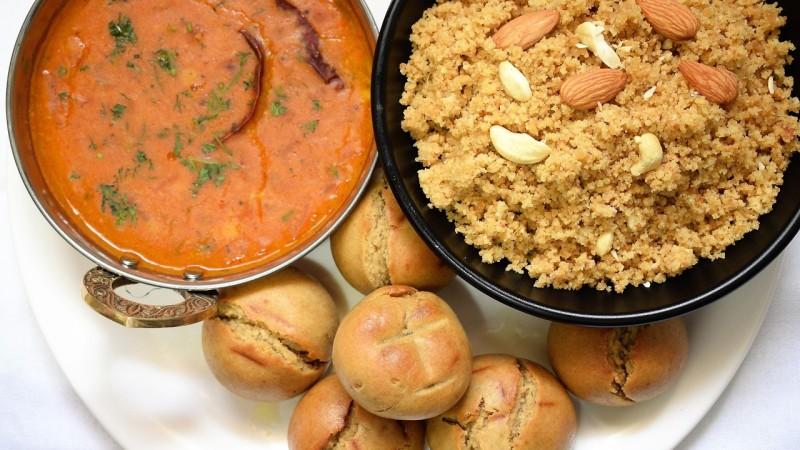
Dal Baati Churma - © gather
Weather in Jaipur: Best Time to Visit
Average Temperatures
- Jaipur has a hot semi-arid climate with long, extremely hot summers and short, mild to warm winters.
- The average temperature ranges from a high of 41°C (106°F) in May to a low of 15°C (59°F) in January.
- The highest temperature ever recorded was 49°C (120°F) on May 23, 1994.
Rainfall
- Annual precipitation averages around 565mm (22 inches), with the majority falling during the southwest monsoon from July to September.
- The wettest month is August with an average of 190mm (7.5 inches) of rain.
- Flooding can occur during heavy monsoon rains, especially in the lower parts of the city.
Best Time to Visit
- The best time to visit Jaipur is from mid-November to mid-February when temperatures are mild and dry.
- However, it can get chilly from mid-December to mid-January, so pack some warm layers.
- Avoid the extremely hot summer months of May and June when temperatures often exceed 45°C (113°F)
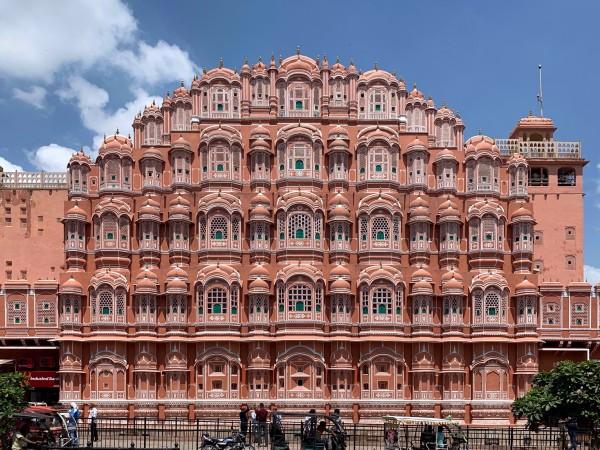
Hawa Mahal Jaipur - © Chainwit
Festivals & Local Celebrations
Teej Festival
Time of Year: August (during the monsoon season)
Teej is a vibrant festival primarily celebrated by women in Jaipur, marking the arrival of the monsoon. Women dress in colorful traditional attire, adorn themselves with jewelry, and apply mehndi (henna) on their hands. The celebrations include singing folk songs, dancing, and swinging on beautifully decorated swings. Visitors can witness processions and rituals at temples, creating a lively and festive atmosphere.
Gangaur Festival
Time of Year: March to April
Gangaur is one of the most significant festivals in Rajasthan, dedicated to Goddess Parvati and Lord Shiva. Celebrated mainly by women, the festival involves the creation of clay idols of the deities, which are paraded through the streets in colorful processions. Visitors can expect to see traditional music, dance, and vibrant decorations, as well as the local community coming together to celebrate marital fidelity and the arrival of spring.
Elephant Festival
Time of Year: March (around Holi)
The Elephant Festival is a unique celebration that showcases the cultural heritage of Rajasthan. Held on the full moon day of Phalgun Purnima, the festival features beautifully adorned elephants participating in parades, along with traditional music and dance performances. Visitors can interact with the elephants, witness traditional games, and enjoy the festive atmosphere, although some activities have been modified to ensure the welfare of the animals.
Kite Festival
Time of Year: January (on Makar Sankranti)
The Kite Festival is celebrated on January 14th and marks the transition of the sun into Capricorn. The skies over Jaipur are filled with colorful kites as locals and tourists alike participate in kite-flying competitions. Visitors can enjoy the festive spirit, watch kite battles, and partake in the joyous atmosphere, with the city coming alive with music and celebrations.
Jaipur Literature Festival
Time of Year: January (usually in the last week)
The Jaipur Literature Festival is Asia's largest literary festival, attracting authors, poets, and literary enthusiasts from around the world. Held in January, the festival features panel discussions, book readings, and workshops. Visitors can engage with renowned authors, attend thought-provoking sessions, and enjoy the vibrant cultural exchanges that take place during this five-day event.
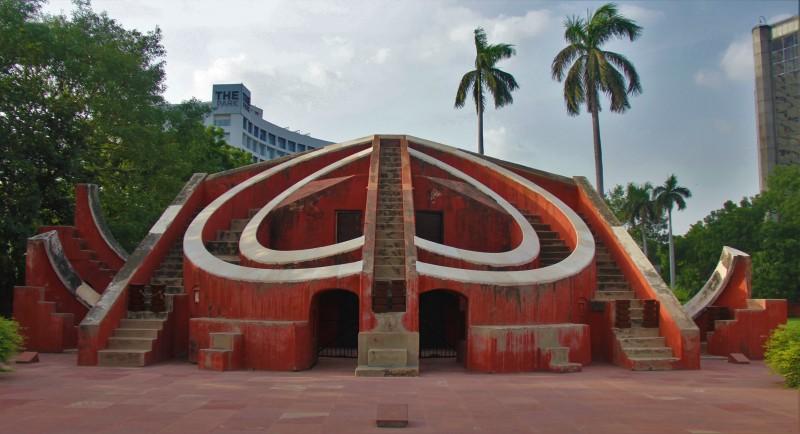
Jantar Mantar - © AKS.9955
Culture Etiquette in Jaipur
Greetings
Namaste: It is customary to greet people with "Namaste" or "Namaskar," accompanied by folding your hands in front of your chest as a sign of respect. Addressing individuals with titles like "ji" (for respect) is also common.
Dress Modestly
Visitors should dress modestly, especially when visiting religious sites. Both men and women should cover their shoulders and knees. Lightweight cotton clothing is advisable due to the hot climate.
Respect Religious Practices
When entering temples or homes, it is customary to remove your shoes and, in some cases, cover your head. Avoid wearing leather products and touching holy books or idols with your feet, as this is considered disrespectful.
Dining Etiquette
If dining with locals, wash your hands before and after the meal, as it is common to eat with your hands. Accepting food or drink offered to you is polite, and if you have dietary restrictions, inform your host in advance.
Photography
Always seek permission before photographing people, especially women and religious sites. Respect the privacy of locals and adhere to any photography restrictions in certain areas.
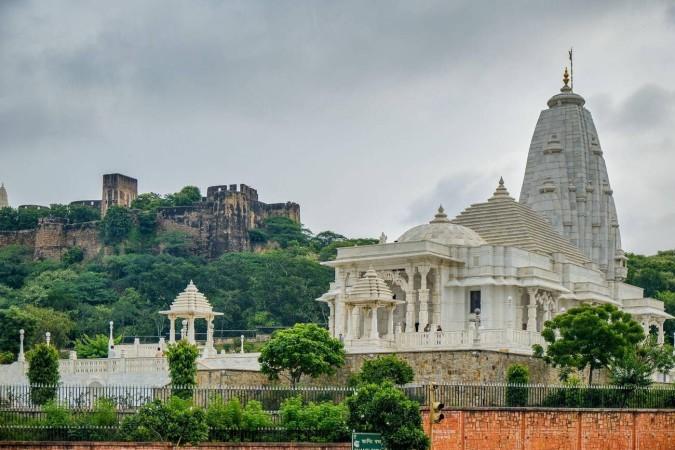
Birla Mandir - © gather
Essential Travel Information
Transportation options
Airport Transfers
- Jaipur International Airport is located about 13 km from the city center.
- Pre-booked private airport taxi transfers are the most convenient option, with drivers meeting you at arrivals. Taxi2Airport and Airports Taxi Transfers are two services that provide this.
- Taxis with yellow license plates are available outside the airport arrivals area, charging by meter.
Public Transit
- The Jaipur Metro commenced operations in 2015, with the first line running from Mansarovar to Chandpole (9.63 km). Phase 1B from Chandpole to Badi Chaupar began in 2020.
- An extensive bus network (routes 1-10) connects different parts of the city, but buses are often overcrowded and delayed.
- Trains are the cheapest option for travel, with Jaipur Junction station serving over 45,000 passengers daily. It connects Jaipur to many major cities.
Taxis and Ride-Sharing
- Pre-booked taxis are the best option for airport transfers and longer trips.
- Metered taxis and auto-rickshaws are available for shorter journeys within the city.
- Ride-sharing services like Uber and Ola operate in Jaipur.
Other Options
Renting a car is possible, but navigating Jaipur's busy streets can be challenging for visitors.
Cycling is a popular way to explore the city's sights, with bicycle rentals available.
ATM and Banking Services
Jaipur has numerous ATMs and banking facilities, ensuring travelers can access cash and banking services conveniently. Some notable ATMs include:
- State Bank of India ATMs: Multiple locations, including Matrix Mall (Sector 4) and Bhagwan Das Road, are available 24/7 for cash withdrawals.
- HDFC Bank ATMs: Also widely available throughout the city, offering 24-hour access.
Travelers can find ATMs in popular areas, ensuring easy access to funds during their stay. Additionally, major banks have branches in the city, providing services like currency exchange and account management.
Accommodation Choices
Jaipur offers a wide range of accommodation options to suit various budgets and preferences:
- Luxury Hotels: Options like the Taj Rambagh Palace, Oberoi Rajvilas, and ITC Rajputana provide opulent stays with world-class amenities and services.
- Mid-Range Hotels: Establishments such as the Holiday Inn Jaipur City Centre and Lemon Tree Premier offer comfortable accommodations with good facilities at reasonable prices.
- Budget Hotels and Guesthouses: For more affordable stays, visitors can choose from numerous guesthouses and budget hotels like Zostel Jaipur and Hotel Pearl Palace, which provide a cozy atmosphere and local charm.
- Heritage Hotels: Jaipur is known for its heritage properties, such as Samode Haveli and Alsisar Haveli, where guests can experience royal Rajasthan hospitality.
Articles for you

Explore Yala National Park - Sri Lanka Travel, Asia
Tucked away in Sri Lanka’s southeastern corner, Yala National Park is where wild nature meets deep tradition. Known worldwide for its leopard population, the park is also home to elephants, sloth bears, crocodiles, and hundreds of bird species. Beyond wildlife, Yala opens doors to a cultural landscape dotted with ancient temples, Buddhist ruins, and coastal villages. For travelers seeking more than just a safari, Yala offers a chance to explore eco-tourism, local communities, and sacred heritage sites.
Population: The Yala National Park area doesn’t have a human population.
Economy: The economy around Yala National Park thrives on a blend of eco-tourism, agriculture, and local services. Safari tours, eco-lodges, and cultural experiences drive steady income for nearby towns like Tissamaharama and Kataragama, supporting thousands of families.
Landmarks: Famous for Block I of Yala and wildlife encounters, including elephants, sloth bears, crocodiles, and exotic bird species.

Explore Galle - Sri Lanka Travel, Asia
Nestled on Sri Lanka’s southern coastline, Galle is a vibrant city where history meets the sea. Its cobbled streets, colonial architecture, and serene beaches make it a must-visit destination for travelers seeking a blend of culture, adventure, and relaxation. A UNESCO World Heritage site, Galle captivates visitors with its Dutch Fort, bustling markets, and friendly locals. Whether you’re exploring the ramparts at sunset or savoring fresh seafood by the shore, Galle promises an unforgettable journey into Sri Lanka’s heritage.
Population: Approximately 113,000 in 2023.
Economy: Galle’s economy thrives on tourism, trade, and fisheries. The city’s historic fort, colonial architecture, and coastal charm draw thousands of international visitors each year, making tourism its main economic driver. Fishing remains vital for local livelihoods, supplying fresh seafood across the region.
Landmarks: Famous for the Galle Fort, Dutch Reformed Church & Maritime Museum, and Unawatuna Beach.

Explore Bentota - Sri Lanka Travel, Asia
Nestled along Sri Lanka’s southwestern coast, Bentota is a tropical paradise that blends golden beaches, vibrant culture, and thrilling adventures. Famous for its calm waters, luxury resorts, and scenic river estuary, Bentota has become a top destination for travelers seeking both relaxation and authentic experiences. From serene beach walks at sunrise to adrenaline-pumping water sports, this coastal town offers a perfect balance of leisure and exploration. With its proximity to Colombo and Galle, Bentota is easy to reach, making it an ideal stop for both short escapes and extended holidays.
Population: Approximately 37,000 in 2023.
Economy: Bentota’s economy thrives mainly on tourism, which drives local businesses such as hotels, restaurants, and wellness retreats. The town also benefits from fishing, coconut cultivation, and handicrafts like wood carving and batik textiles. Many residents rely on the growing demand for water sports and Ayurvedic treatments, making tourism the backbone of both income and employment in the area.
Landmarks: Famous for Bentota Beach, Bentota River Safari, and Kande Vihara Temple.

Explore Mirissa - Sri Lanka Travel, Asia
Mirissa is a charming coastal town on Sri Lanka’s southern shoreline. Known for its golden beaches, turquoise waters, and vibrant marine life, it has become a must-visit stop for travelers exploring the island. Many come for whale watching, surfing, and sunset views at Coconut Tree Hill, but Mirissa offers much more than postcard beauty. The fishing boats you see anchored by the bay carry generations of stories. Local traditions, delicious cuisine, and a laid-back rhythm of life shape every visitor’s experience.
Population: Approximately 4,700 in 2023.
Economy: Mirissa’s economy is largely shaped by its coastal location. Fishing has long been the backbone of local livelihoods, with generations relying on the Indian Ocean for income. In recent decades, tourism has become the main driver of growth, thanks to whale watching, surfing, and beachside hospitality.
Landmarks: Famous for Mirissa Beach, Coconut Tree Hill, and Parrot Rock Bridge.

Explore Nuwara Eliya - Sri Lanka Travel, Asia
Tucked away in the Central Highlands of Sri Lanka, Nuwara Eliya is often called “Little England”. With its rolling tea plantations, cool misty mornings, and colonial charm, this mountain town feels like a step into another world. Travelers come here to breathe fresh air, walk through flower gardens, sip the finest Ceylon Tea, and enjoy a pace of life far from the island’s busy cities. Whether you’re drawn by scenic landscapes, heritage architecture, or the warmth of its people, Nuwara Eliya is a destination that blends nature, culture, and history in perfect harmony.
Population: Approximately 781,000 in 2023.
Economy: Nuwara Eliya’s economy thrives mainly on tea production, as it sits in the heart of Sri Lanka’s central highlands, famous worldwide for Ceylon Tea. The city also benefits from a growing tourism industry, attracting visitors with its colonial charm, cool climate, and scenic landscapes.
Landmarks: Famous for Gregory Lake, Hakgala Botanical Garden, and Victoria Park.

Explore Sukau - Malaysia Travel, Asia
Nestled on the banks of the Kinabatangan River in Sabah, Malaysian Borneo, Sukau is a destination where wildlife, culture, and conservation come together. Known as one of Asia’s top spots for river safaris and eco-tourism, this quiet village offers a front-row seat to encounters with Bornean orangutans, pygmy elephants, proboscis monkeys, and exotic birdlife.
Population: Approximately 1,400 in 2019.
Economy: Sukau’s economy is shaped by its riverine location and natural resources. Traditionally, the Orang Sungai community relied on fishing, small-scale farming, and forest gathering for their livelihood. Today, the village has shifted toward eco-tourism, with river cruises, jungle trekking, and homestays providing income.
Landmarks: Famous for the Kinabatangan River cruises, Gomantong Caves, and Ox-bow lakes and wetlands.
